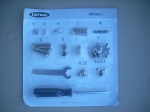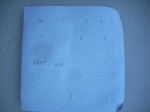 As a former technical writer, it’s always disappointing to see the sad state of virtually any kind of instruction manual or guide. These documents are literally afterthoughts, included I’m sure, simply because laws require assembly instructions or usage manuals.
As a former technical writer, it’s always disappointing to see the sad state of virtually any kind of instruction manual or guide. These documents are literally afterthoughts, included I’m sure, simply because laws require assembly instructions or usage manuals.
In fact, too often with goods made in non-English speaking countries, you end with documents like this.
So, when I come across a set of instructions that is clear, unambiguous and easy to understand, it’s worth a positive shout out.
Recently, I bought a rather inexpensive charcoal grill. It looks like this grill to the right.
Nothing fancy. It’s not from a major name brand. But whomever created the assembly instructions knew what they were doing.
First, here is a shot of the COMPLETE assembly instructions
(click image to enlarge)
What’s great about this?
- 8 simple panels, shown clearly on a 2 page spread
- All parts clearly drawn and all assembly pieces identified and labeled with a letter
- Minimal text to read and (mis)interpret – i.e. no tab A in slot B silliness
Yes, this particular photo shows the French instructions (it came with similar English instructions as well), but to be honest, the words could have been in any language and it wouldn’t have affected the clarity of the diagrams.
Here’s a close up look at one of the panels.
(click image to enlarge)
Note the letters associated with each of the 4 items in the diagram (bolt, 2 different washers, and a nut). Why is this important. Well take a look at the next two pictures.
(click image to enlarge)
Every item required for assembly is clearly packed and labeled (!!!) for easy access and identification. How easy? Notice that items B, G, K, F (used in the 2nd image above) are actually packaged together in the picture!
They could have just put everything into little plastic bags, tossed them into the box, and let me figure out what was what, like many manufacturers do. But someone (I don’t know if Uniflame has Product Managers) decided that would not be acceptable. And on top of that, they included the tools I’d needed — screwdriver and small wrench — to put everything together.
But that’s not all. Whomever designed this little package of assembly parts, went one step further. Here’s the back of the package.
(click image to enlarge)
Yup. The letters are also printed on the back. So why is this important? Because the back is where someone assembling the barbecue is going to access the parts. Note the serrations in the cardboard.
Someone actually thought through this little detail and decided to print the part letters on the back and serrate it for easy access. And believe me, it saved me a lot of flipping the package over and back to figure out where the parts were that I needed.
Now, this is not a complicated grill to put together. It could be done with poor instructions, but it does say to me that someone at Uniflame actually cares about customer experience. None of the points listed above are big things, nor are they costly to implement, but in most cases, companies bypass the extra effort altogether, looking at them as expenses and not as value-add.
And because UniFlame chose the latter, I’m telling all of you. So, if any of you are looking for a good charcoal grill, go and get this one from your local retailer. It’s about 1/2 the price of the comparable big name brand, and it works really well.
So, hats off to you Uniflame. You’ve impressed one product geek enough that he decided to let a lot of other people know.
Saeed



